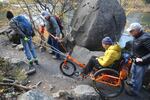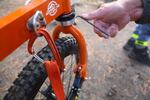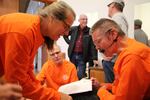Five people move in tandem down a trail as it gets steeper and narrower than the bright orange metal frame connecting them.
This trail, popular with Bend, Oregon, families, is a testing ground for inventor Geoff Babb, and the stakes couldn’t be higher.
One miscalculation about how to navigate the tight squeeze of boulders, and he could topple over the edge toward an ice-cold river below. But, that’s not what worries Babb, who hasn’t walked since a stroke 14 years ago.
“I don’t feel scared on the trail. I trust these guys to figure it out, how to get through those narrow spots without tipping me over,” he said.
As the team lifts him over rocks, Babb focuses on how certain components are working. He’s invested countless hours in this prototype for a new style of an all-terrain wheelchair.

Navigating the trail with an AdvenChair rider requires problem solving and teamwork.
Emily Cureton / OPB
“Look at the river, the serviceberry, the color. The sun is out. There’s no way we could get back here with a regular wheelchair,” he said.
Babb is recovering from two strokes with the help of his wife, Yvonne, family, and many friends.
“My stroke affected my whole body. It’s called quadriparesis, or weakness in all four limbs,” he explained.
Even though stroke is the leading cause of serious disability in the nation, he found existing all-terrain wheelchairs didn’t suit his needs — some are too frail, others require upper body strength, and motorized options aren’t allowed on many trails.
Babb began envisioning a new design to help himself and other outdoor enthusiasts with serious disabilities.
The AdvenChair was born.
It’s a mountain bike-inspired product, with treaded tires, handlebars and disc brakes, but it’s also a team sport. Between one and six people can help push, pull and steer the rider.

Designers say the chair's bike and climbing components make it durable, and easier for people to operate without special training.
Emily Cureton / OPB
“Even though we have a planned route, you don’t always know what you are going to encounter along the route,” said Amy Kazmier, a friend and so-called “mule.”
The nickname for people who power the chair came after a fateful trip to the Grand Canyon in 2016. An axle broke in the famously steep terrain, and “we had to take his chair apart and carry it up the hill,” Kazmier recalled.
The failure changed the course of the project.
“We had to do a completely different design,” said Jack Arnold, a product development engineer.
They looked to the outdoor sports industry to strengthen the frame.
“The AdvenChair is not based on wheelchair parts. It's based on mountain bike components ... [which] are more durable than wheelchair parts and less expensive. And there are bike mechanics all over the place,” Arnold said.

Geoff Babb hikes with help from his friends Jack Arnold and Amy Kazmier.
Emily Cureton / OPB
But building a prototype has been costly — totaling around $10,000. Meanwhile, Babb anticipates the chair won’t be considered a medical device, which means it wouldn’t be covered by health insurance. Instead, they’re pitching the idea to tourism companies that lead adventure trips for people with disabilities.
This fall the team competed for startup funding against outdoor gear companies from all over the Pacific Northwest at the Outdoor Worx competition in Bend. It’s a "Shark Tank" style contest for entrepreneurs, with a $5,000 prize for early-phase companies like AdvenChair. Babb had seven minutes to pitch the audience.
“This project is bigger than us, bigger than the team and the community that supports us,” he said, then closed by listing people he’s shared the chair with so far.
One was in the audience. Michelle Pearson had a stroke four years ago.
“The regular wheelchairs that you get are not designed to be outdoors,” she said, describing how her chair broke just getting out the front door.
Last year, a trip in the AdvenChair was her first time on a trail since she became disabled.
“It was just a great day. It felt really good to get out there. And not just your yard, and not just your street, not just driving around your car looking out the windows."
She hasn’t been on a hike since.
When the results of the startup competition came in, she was in the back of the auditorium, cheering hard.

Yvonne and Geoff Babb preparing to pitch AdvenChair at the 2019 Bend Outdoor Worx competition.
Emily Cureton / OPB
Babb’s team sent him up the stairs to collect the $5,000 check. The win has boosted a project shaped by extreme setbacks, but there’s still a ways to go.
Babb is applying for a patent and this spring the team has plans to go back to the Grand Canyon and test the mettle of their latest design.

